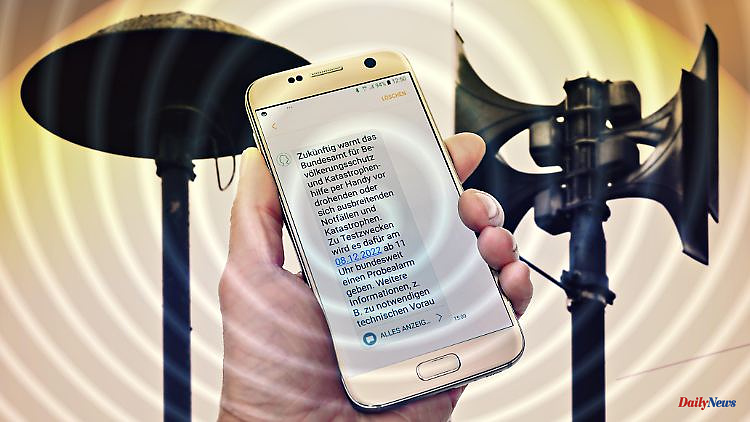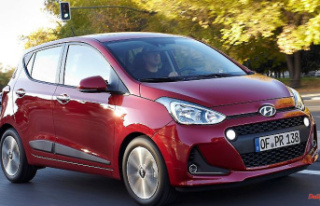December 8th is the nationwide warning day, when cell broadcast is used for the first time. Smartphones can use it to automatically receive messages. Theoretically, because although the technology is old, many cell phones in Germany will probably remain silent.
In the event of a catastrophe, in which people must be warned as quickly as possible, Germany was recently very poorly prepared, as the flood disaster of the past year tragically showed. The sirens that used to be on many roofs no longer existed. Apps that should warn instead were not installed, informed too late or not at all. For this reason, cell broadcast (CB) should now be tested for the first time on the nationwide warning day from 11 a.m. With this technology, messages can be sent to all smartphones that are in endangered areas in the mobile network.
In principle, cell broadcast is wonderfully simple and perfectly suited for warnings. Only texts with a maximum of 500 characters can be sent, but more is initially not necessary. It is more important that the warnings reach the recipients in a matter of seconds.
No app has to be installed for this, you don't have to register. Not even a German SIM card is required, and the service also works in heavily loaded networks. Even if the smartphone is muted, an alarm will sound when the alert arrives. The mobile phone only has to be switched on and ready to receive. This means that the device should not be switched off or in flight mode, nor should it be within earshot, even at night.
Unfortunately, things are not that simple for every user. In theory, all smartphones can receive cell broadcast alerts, including older ones. The technology has been used since 1999 and is part of the radio standard, whether 2G, 3G, 4G or 5G. However, the service must first be activated in the settings on some devices, and it is not uncommon for it to only work after the manufacturer has updated the firmware.
In principle, cell broadcast should be possible with all Apple smartphones from the iPhone 6s and all Android devices from Android 11. However, CB-enabled iPhones have the problem that at least iOS 15.6.1 must be installed, which Apple released in August. However, a number of iPhone users often delay installing updates because they want to await possible complications. It's also not uncommon for owners of older devices to remain on an earlier software version, fearing that the latest firmware might slow down their iPhone.
If an iPhone runs iOS 15.6.1 or higher, Cell Broadcast is automatically active. The test warnings should then also be received if test warnings are not set to green in the settings. By default, only CB messages in the event of extreme danger and danger information are switched to green. However, the messages on the warning day are sent with the highest warning level, i.e. as if the situation was genuinely dangerous.
If you want to be sure, go to Notifications in Settings, scroll all the way down to Cell Broadcast Alerts and tap on the slider behind Test Alerts. It is questionable whether Apple will release any more updates that will also make the iPhone 6 (Plus) and older devices fit for cell broadcasting.
In principle, the same applies to devices with Android 11 as to iPhones with the latest software: cell broadcast is automatically activated, the messages on December 8th are also received if test warnings are not activated. The Federal Office for Civil Protection and Disaster Assistance (BKK) has published a list of smartphones from Google, Samsung and Sony that are sure to be CB-enabled.
In contrast to Apple devices, there is no really defined limit for Android as to whether the service works or not. Manufacturers may have already integrated the function in earlier versions of the operating system or published a corresponding update - Google provides a CellBroadcast module for this. Samsung, for example, has published instructions showing how to activate emergency notifications via cell broadcast on smartphones with Android 10 or older.
The function can be found on the South Koreans' devices in the news app. There you tap on the top right on the three-point symbol, then on Settings and then on More settings. Here you activate broadcast channels with all transmitters. In the news app, you can check the cell broadcast settings in the same place on Samsung devices with Android 11 or higher.
On Google's Pixel smartphones, you can find the function in the settings under Security and emergencies - emergency notifications for mobile devices. The function is also called on most other Android devices, for example Sony and Xiaomi. If you can't find it in the same place, the easiest way is to use the search function in the settings.
Overall, however, there will be many smartphones on the warning day that will not receive any messages via cell broadcast. According to Statcounter, only about half of Android devices worldwide have Android 11, 12 or 13 installed. In Germany, the proportion is probably much higher, but there are still many old androids here too. Things are looking a little better with the iPhones, according to Mixpanel, iOS 15 and 16 are already installed on more than 90 percent of the devices.
Smartphone users who are not suitable for cell broadcasts do not have to do without important messages in an emergency. The BKK recommends that you install the warning app NINA. The authority also refers to the regional use of the apps KATWARN and BIWAPP or the HessenWARN app. However, some of these applications failed during the flood disaster last year. They have to show on the warning day that they can do better now.












